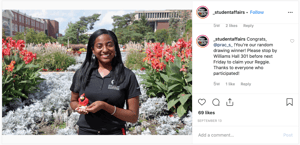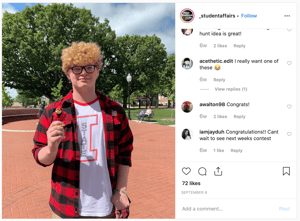How to Build an Influencer Program in Higher Ed

We know students' methods for communication evolve regularly. The higher education industry needs to evolve along with those methods so we remain relevant in the minds of students.
Influencer marketing is an innovative strategy that has developed as individuals become more influenced by their peers than by businesses or organizations. Student influencer marketing strategically reaches students through their peer networks. Corporations and big brands have used effective peer marketing campaigns since 2010, but few higher education institutions, especially in student affairs, are taking advantage of this new strategy. In 2017, the Division of Student Affairs at Illinois State University launched one of the only formal student influencer teams in student affairs divisions nationwide.*
Student Influencer Program in Student Affairs
The #YourRedbirdLife Student Influencer program is the heartbeat of the Division of Student Affairs marketing and outreach efforts at Illinois State University. The student team activates their personal networks and taps into a variety of areas and peer groups on campus to influence and increase brand awareness of and engagement with the division.
Positions on the team are open to all students of all majors, with qualifications including previous involvement on campus and active participation on Facebook, Twitter, and Instagram. Our influencers typically work five hours per week and the program pays minimum wage for completing weekly requirements, including a weekly progress report that outlines their activity and a specific number of likes, shares, and comments on posts per week. We may ask team members to appear in divisional videos, such as the "Weekly What's Happening." And we ask team members to follow all student affairs accounts, then like and share the strategic content on various platforms. Influencers further increase the division’s online engagement by commenting on posts and writing reviews.
With representation across all areas of campus, the #YourRedbirdLife student influencer team assists the division in reaching new subpopulations of students on campus. This strategy uses micro-influencers by tapping into smaller pockets of students, allowing the division to reach students who haven’t been involved yet.
We use social media analytics to assess the program, monitoring the accounts daily for reach, engagement, and total followership. A marketing graduate assistant checks the accuracy of students' work by comparing the accounts to the students' time logs. We also hold focus groups with students to obtain qualitative feedback on the type of content they want to engage with on social media, what is trending, who they follow, and what they want to know from student affairs. Finally, we conduct benchmarking to determine how other institutions might use influencer strategies.
The student influencer program and a creative and strategic social media content plan have tremendously impacted the performance of our social media platforms, including Facebook, Twitter, and Instagram. In the first two years, our audiences grew across these accounts by 245 percent! We also increased our digital engagement by comparing time frames when influencers are active and inactive. For example, when we reactivated student influencers during the first week of classes in 2019, our engagement increased by 82 percent compared to the previous week.
Building an Influencer Program
There’s a lot to consider when building an influencer program on your own campus.
- Diverse Representation. Beyond striving for the inclusion of multiple identities, consider hiring students from varying majors, graduation years, and areas of involvement. This allows departments to identify smaller communities on campus through a micro-influencer strategy. Look for smaller pockets of campus you’d like to reach and find students who have access to those networks. The primary goal of an influencer program is to reach areas of campus that currently don't engage on social. It may be helpful to consider student leaders, but influencer programs should not rely exclusively on them.
- Training. Because influencer marketing is an emerging trend, it’s critical to educate student influencers on the strategy of the program, its impact, and their role in its success. At Illinois State, we partnered with digital leadership consultant Dr. Josie Ahlquist to create an online training module for the student influencer team. The module offers influencers convenient access to training by taking them through a series of video tutorials and exercises.
- Criteria and Expectations. Put established criteria in place to provide measurable direction for the influencers. Expectations are also helpful given the additional considerations that come with students using their personal social accounts to spread awareness about student affairs. Collectively review and agree to the expectations at the beginning of student employment. This outlines and holds influencers accountable to weekly requirements and indicates your expectations of them.
- Resources. Access to resources is crucial in order to compensate students. If you don’t have paid positions, it’s more challenging to gain student buy-in. Paying students legitimizes the experience as an employment opportunity that assists with their career development and holds them more accountable for weekly requirements.
- Strategic Content Plan. An influencer program can’t be successful without a strategic content plan for social media. The plan should outline goals, a master schedule, and different strategies for each major platform, including a plan for interesting, relatable content influencers can use to engage students.


- Authenticity. Allow influencers to share content they choose so they build trust and buy-in with their audiences. Influencers feel more comfortable in their roles when they have control of choosing the content they engage with. Giving influencers this freedom resonates with them and helps maintain authenticity in the program.
- Ethics. The program is an example of ethical marketing practices that builds on the trust and authenticity of peer influencers and fellow students. Make it clear that influencers are employed as part of the overall social media strategy. For example, influencers at Illinois State always introduce themselves as part of the influencer team when they appear in divisional videos. To comply with the Federal Trade Commission guidelines, influencers must disclose their relationship with the organization as a paid influencer. It’s important to watch for trends in social influencer marketing strategies and other ethical considerations as these programs and tactics evolve.
Student Learning Outcomes
The Division of Student Affairs isn’t the only benefactor of this program; student influencers benefit from the employment experience. Specific student learning outcomes include fulfillment from contributions made to the campus community, practical work experiences, a sense of belonging, and identity development.
“Being a social media influencer has helped me discover who I am and what my role is at Illinois State,” says senior Julia Durnell, an Illinois State influencer. “My favorite part about this job, though, is the community and family that it brought to my life.”
* Rolfs, M., Ahlquist, J., & Johnson, L. (2019). "Influencer Marketing in Student Affairs." NASPA: Leadership Exchange, 17(3), 38–39.

